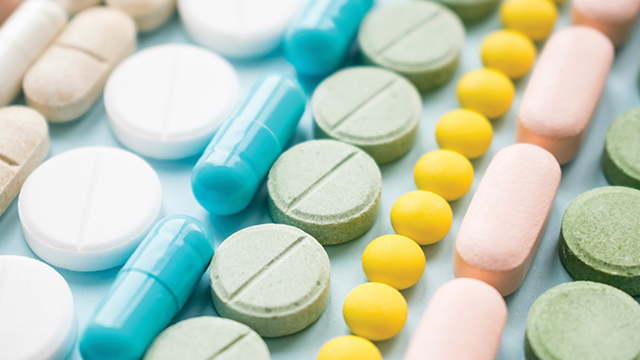Handling Controlled Substances in the Lab
The heart of good controlled substance management is a comprehensive written program

In the broad realm of research laboratories, some may deal with narcotics, stimulants, depressants, hallucinogens, anabolic steroids, or other chemicals used in the production of drugs. These are commonly referred to as “controlled substances” (i.e., they are strictly controlled by federal regulations). If we are using any of these materials in our research, (e.g., animal research, or practices such as veterinary services,) then we need to be very careful in how they are secured and accounted for.
Controlled substances defined
The term “controlled substances” refers to drugs and other substances listed on one of the five schedules published in the Controlled Substance Act, Title 21 Code of Federal Regulations, Parts 1308.11 through 1308.15.1 Chemical substances are placed on the schedules based on three primary characteristics: currently accepted medical treatment use in the United States, relative abuse potential, and likelihood of causing dependence when abused. Below are simple definitions of each schedule and a few common examples of each substance.
- Schedule I substances have no currently accepted medical use in the US, a high potential for abuse, and a lack of accepted safety for use under medical supervision. Examples include heroin, LSD (lysergic acid diethylamide), marijuana (cannabis), and ecstasy (methylenedioxymethamphetamine).
- According to 21 CFR 1308.12, Schedule II substances are primarily narcotics or stimulants that have a high potential for abuse, which may lead to severe psychological or physical dependence. Narcotic examples include codeine, hydrocodone, morphine, opium, barbitals, and the well-known oxycodone (OxyContin, Percocet) and hydromorphone (Dilaudid). Stimulant examples include amphetamines (Dexedrine, Adderall) and methamphetamine (Desoxyn).
- Schedule III substances have less potential for abuse than do Schedule I or II substances, and abuse may lead to moderate or low physical dependence or high psychological dependence. These include products containing not more than 90 milligrams of codeine per dosage unit (Tylenol with Codeine) and buprenorphine (Suboxone). An anabolic steroid such as Depo-Testosterone is an example of a non-narcotic Schedule III substance.
- Substances in this schedule have a lower potential for abuse than do substances in Schedule III. Examples include alprazolam (Xanax), carisoprodol (Soma), and diazepam (Valium).
- Schedule V substances have a lower potential for abuse than do substances listed in Schedule IV and consist primarily of preparations containing limited quantities of certain narcotics. Examples include cough preparations containing not more than 200 milligrams of codeine per 100 milliliters or per 100 grams (Robitussin AC, Phenergan with Codeine).
However, we need to understand that the controlled substance schedules currently list approximately 160 specific substances, and the schedules do not constitute a comprehensive listing of all controlled substances. The schedules describe only basic or parent chemicals and do not list all the salts, isomers, and salts of isomers, esters, ethers, and derivatives that may be controlled substances.
For example, if a substance is an analogue and is structurally or pharmacologically substantially similar to or is represented as being similar to a Schedule I or Schedule II substance and is intended for human consumption but is not an approved medication in the US, it can be treated as a Schedule I substance for criminal prosecution.
Management plan
The main focus and important information you should take away from this article is that before you begin using any controlled substance in the lab, you should have all the appropriate licenses and registrations and have a robust program in place for managing and safeguarding these materials.
The heart of good controlled substance management is a comprehensive written program. Your certified safety management practitioner (CSMP) should address everything from acquisition to final disposal and include vigorous training, security, record keeping, and follow-up. It should clearly list the responsibilities of all stakeholders such as the CS coordinator, principal investigators, and other authorized personnel. Clearly indicate the steps for purchasing, receiving, storing, and disposal. Place extra attention on access restrictions, personnel screening, spill procedures, and handling diversion, loss, or theft.2
Related Article: Out of Control
Licensing and registration are critical and must be secured prior to any acquisitions. After you obtain your state license, you need to then register with the federal Drug Enforcement Agency (DEA). Excellent step-bystep instructions with explanations are provided on the DEA registration website.3 Pay attention to your specific research requirements for both state and federal applications. The registration is an absolute must, so make sure to apply early. State licenses usually renew every two years, whereas the DEA registrations must be renewed annually.
Set up your on-site tracking following your CSMP, beginning with receiving material through inventory listing, storage, and control during dispensing and ending with use or disposal record keeping. Do not underestimate the importance of safe, secure storage with tightly controlled access.
Finally, make sure your program has well-documented disposal procedures. You must understand that controlled substances are not considered hazardous waste, biological waste, or regulated medical waste. Therefore, they cannot be disposed of through your normal biological/medical/hazardous waste programs. Your CSMP should have requirements to return all unused or expired material to the original manufacturers or distributors or to set up reverse distributors—specialty contractors knowledgeable and approved for handling controlled substances.
Disclaimer
This article is intended to address the use of controlled substances in research, instruction, and analytical laboratories. The suggestions may be applied to medical clinical activities, medical veterinary hospitals, or pharmacies, but these are governed by federal and state accrediting and regulatory agencies and are subject to review and audit by those agencies.
References:
1. Title 21 Code of Federal Regulation, Part 1308-Schedules of Controlled Substances, US Department of Justice, Drug Enforcement Agency, Office of Diversion Control. Springfield, VA. 2015. https://www.deadiversion.usdoj.gov/21cfr/cfr/2108cfrt.htm
2. Handling and Safeguarding of Controlled Substances for Nonhuman Use, National Institutes of Health. Rockville, MD. July 2016. https://policymanual.nih.gov/1345/
3. DEA Registration, US Department of Justice, Drug Enforcement Agency, Office of Diversion Control. Springfield, VA. 2015. https://www.deadiversion.usdoj.gov/drugreg/index.html
